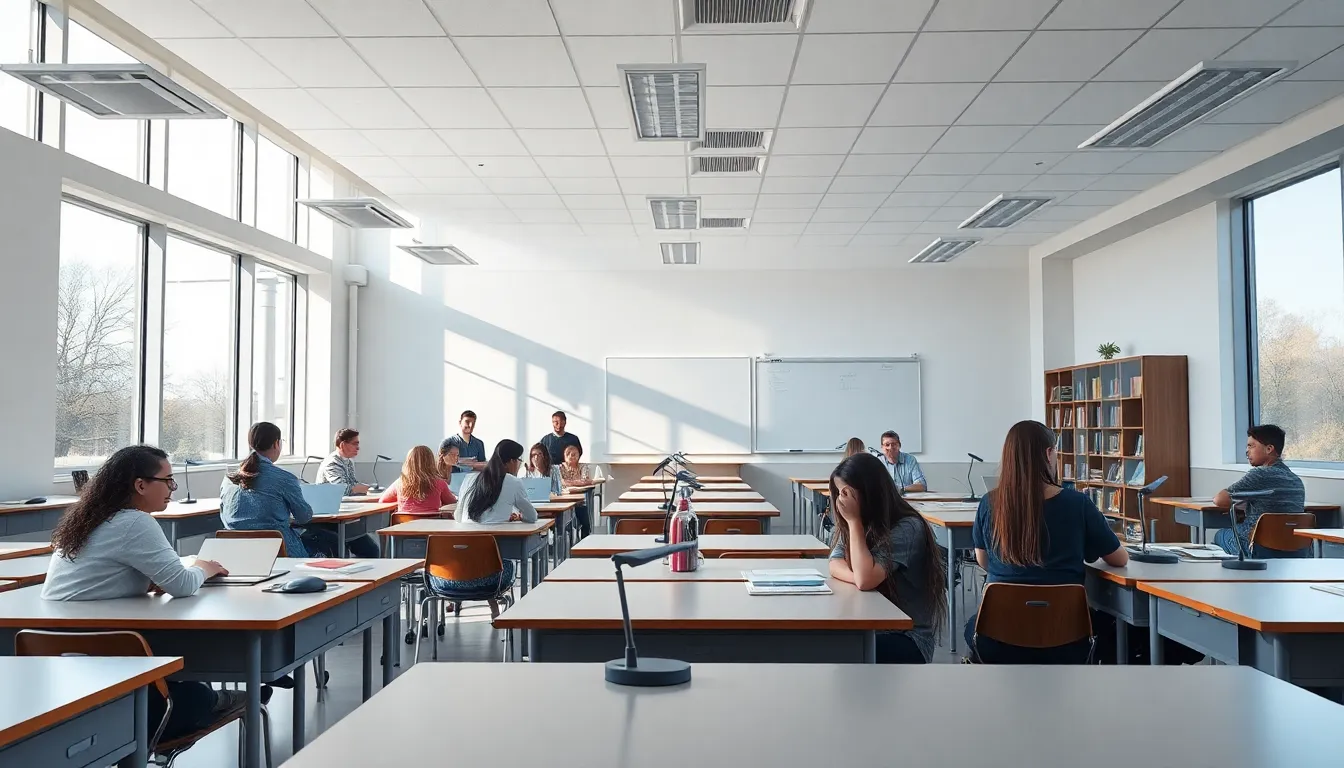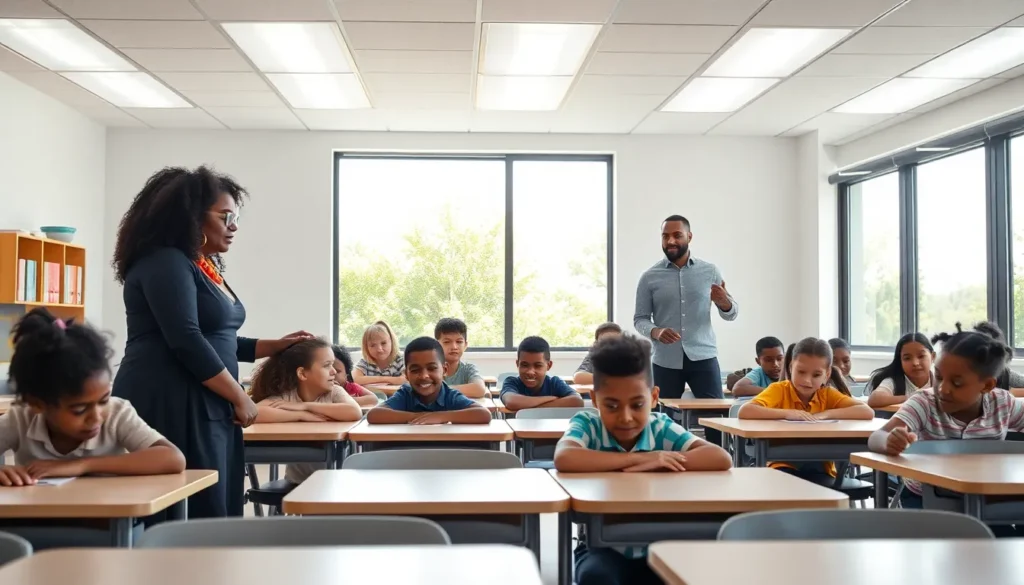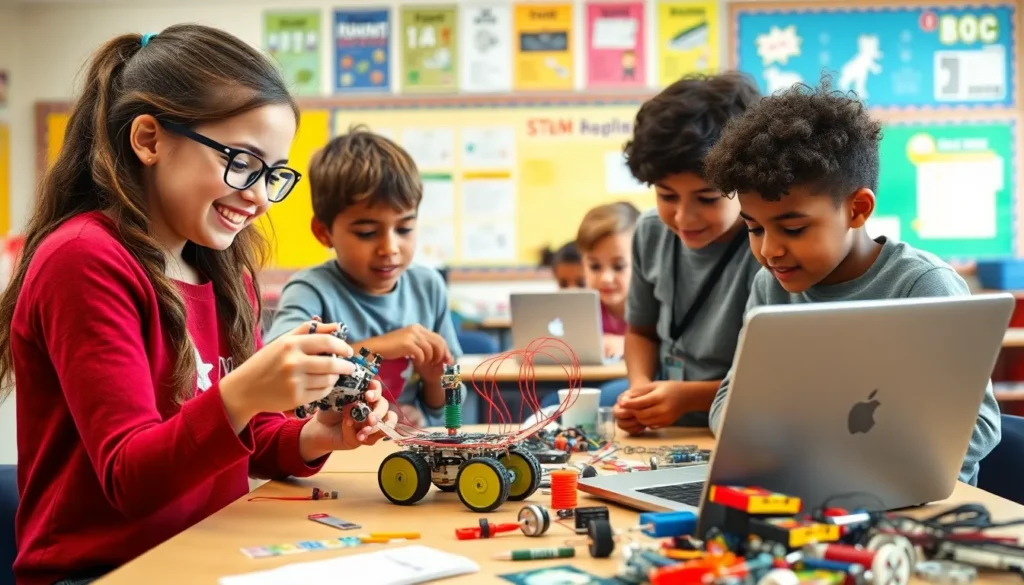Table of Contents
ToggleIn a world where students can barely stay awake during class, the right lighting can be a game changer. Imagine a classroom where the lights are so bright and inviting that even the sleepiest teenager perks up and pays attention. School lighting solutions aren’t just about flipping a switch; they’re about creating an environment that boosts focus and enhances learning.
From LED panels that mimic natural daylight to smart systems that adjust to the time of day, the options are as varied as a cafeteria menu. Investing in proper lighting means investing in brighter futures—because let’s face it, no one wants to navigate through a dimly lit maze just to find their math book. With the right approach, schools can illuminate minds and spark creativity, one light bulb at a time.
Overview of School Lighting Solutions
Effective school lighting solutions play a crucial role in enhancing learning environments. Proper illumination not only boosts student engagement but also contributes to better academic performance.
Importance of Adequate Lighting in Schools
Adequate lighting in schools significantly impacts student concentration and mood. Studies show that well-lit classrooms enhance information retention. Lower energy lighting, such as LEDs, reduces eye strain, creating a comfortable setting for students and teachers. Research indicates improved classroom performance with natural light sources, promoting alertness and reducing fatigue. Quality lighting solutions also support teachers by providing clarity in visual aids and materials.
Key Features of Effective School Lighting
Effective school lighting integrates several essential features. Energy efficiency stands as a primary consideration, as LED fixtures consume less energy than traditional bulbs. Adjustable lighting options allow customization according to specific classroom activities, promoting versatility. Smart technology enhances control with automated adjustments based on occupancy and natural light levels. A uniform light distribution ensures every corner of the classroom receives adequate illumination, supporting inclusivity for all learners. Finally, the color temperature of lights can mimic daylight, fostering a stimulating and engaging atmosphere.
Types of School Lighting Solutions

Different types of lighting solutions play a critical role in enhancing classroom environments. These solutions can be categorized into natural lighting approaches and artificial lighting options.
Natural Lighting Approaches
Natural lighting enhances the learning atmosphere significantly. Windows and skylights allow sunlight to illuminate classrooms, promoting a warm and inviting ambiance. Daylight integration encourages positive moods and fosters creativity. Positioning classrooms to maximize natural light exposure becomes essential, particularly in areas with ample sunlight. Proper window treatments control glare while maintaining brightness. Incorporating light tubes can also channel sunlight into interior spaces without direct windows.
Artificial Lighting Options
Artificial lighting provides flexibility when natural light is insufficient. LED fixtures serve as energy-efficient solutions that last longer than traditional bulbs. Adjustable lighting controls cater to various activities, such as testing or collaborative projects. Smart lighting systems dynamically adjust based on occupancy and time, promoting energy conservation. Task lighting, like desk lamps, supports focused work and reduces strain. Layered lighting, combining ambient and task options, creates a balanced environment that maintains engagement.
Benefits of Modern School Lighting Solutions
Modern school lighting solutions bring numerous advantages. Effective lighting creates engaging and supportive environments for students.
Enhanced Learning Environments
Enhanced learning environments thrive under quality lighting. Exposure to bright, natural-looking light helps boost student concentration and mood. Studies show that well-illuminated classrooms significantly improve information retention rates. Creating inviting spaces with proper light distribution promotes a sense of comfort for both students and teachers. Natural light options, like windows and skylights, inspire creativity while artificial solutions supplement brightness during darker hours. Schools utilizing dimmable lights allow for adjustments based on varied activities, making each classroom experience tailored to specific learning needs.
Energy Efficiency and Sustainability
Energy efficiency stands as a key benefit of modern lighting solutions. LED fixtures consume approximately 75% less energy than traditional lighting options. Utilizing smart systems further optimizes energy use, adjusting automatically based on classroom occupancy or daylight availability. Sustainability also plays a crucial role in selecting lighting solutions. Long-lasting LED bulbs reduce waste and lower maintenance costs due to their extended lifespan. Schools that prioritize eco-friendly lighting contribute to lower carbon footprints, fostering responsibility and awareness within their student populations. Adopting energy-efficient technologies showcases a commitment to both the environment and educational quality.
Considerations for Implementing School Lighting Solutions
Implementing effective lighting solutions in schools requires careful consideration of various factors. Attention to budget constraints and adherence to building regulations facilitates a successful installation.
Budget Constraints
Budget constraints often dictate the choice of lighting solutions in educational settings. Schools may need to balance the initial investment with long-term operational cost savings. Prioritizing energy-efficient options like LED fixtures helps reduce electricity costs. These fixtures use about 75% less energy than traditional bulbs, making them a smart choice for schools on a tight budget. Regular maintenance expenses decrease significantly with durable LED solutions. Schools benefit from suppliers and manufacturers that offer bulk purchasing options, ensuring affordability.
Building Regulations and Standards
Building regulations and standards play a crucial role in selecting appropriate lighting solutions. Local codes often dictate minimum illumination levels for educational spaces, ensuring safety and comfort. Compliance with regulations fosters a supportive learning atmosphere. Additionally, schools must consider accessibility guidelines to cater to all students. Adhering to lighting quality standards impacts student performance and engagement positively. It’s essential to consult with professionals familiar with these regulations before implementation. Proper planning ensures adherence while maximizing the benefits of modern lighting technologies.
Investing in effective school lighting solutions is crucial for enhancing the learning environment. By prioritizing quality lighting that meets the needs of both students and teachers, schools can create spaces that promote engagement and improve academic performance.
The integration of natural and artificial lighting options ensures that classrooms remain adaptable and conducive to various activities. Additionally, energy-efficient solutions not only reduce costs but also contribute to a sustainable future.
As schools continue to evolve, embracing modern lighting technologies will play a vital role in fostering creativity and supporting the overall well-being of students. A well-lit classroom is more than just a necessity; it’s an essential component of a thriving educational experience.







